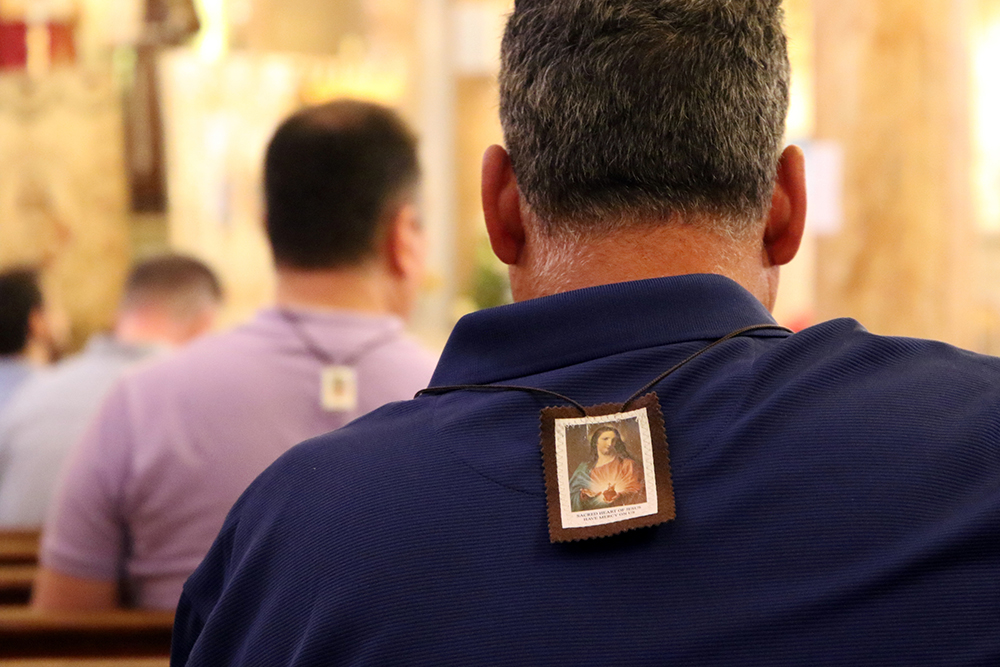On July 16, 1251 the Blessed Virgin Mary appeared to St. Simon Stock, a Carmelite friar, in Aylesford, England. She told him, “Receive, my beloved son, this scapular of thy order; it is the special sign of my favor, which I have obtained for thee and for thy children of Mount Carmel. He who dies clothed with this habit shall be preserved from eternal fire. It is the badge of salvation, a shield in time of danger and a pledge of special peace and protection.”
A scapular is two pieces of cloth connected over the shoulders by strings or cords. Religious often wear a long one as part of their habit. Lay people began to desire to share in the blessing that Our Lady gave to the Carmelites and wore a smaller scapular under their clothing. There are eight different Marian scapulars, but the brown scapular of Our Lady of Mt. Carmel is the most popular and best known. It is a sacramental of the Church.
Sacramental
According to Canon 1166 in the Code of Canon Law, “Sacramentals are sacred signs which in a sense imitate the sacraments. They signify certain effects, especially spiritual ones, and they achieve these effects through the intercession of the Church.” The Directory of Popular Piety, No. 205, says, “The scapular is an external sign of the filial relationship established between the Blessed Virgin Mary, Mother and Queen of Mount Carmel, and the faithful who entrust themselves totally to her protection, who have recourse to her maternal intercession, who are mindful of the primacy of the spiritual life and the need for prayer.”
Pope St. John Paul II, on the 750th anniversary of the scapular, wrote:
“The sign of the scapular points to an effective synthesis of Marian spirituality, which nourishes the devotion of believers and makes them sensitive to the Virgin Mother’s loving presence in their lives. The scapular is essentially a ‘habit.’ Those who receive it are associated more or less closely with the Order of Carmel and dedicate themselves to the service of Our Lady for the good of the whole Church. Those who wear the scapular … experience the loving and motherly presence of Mary in their daily commitment to be clothed in Jesus Christ and to manifest him in their life for the good of the Church and the whole of humanity.”
“Therefore two truths are evoked by the sign of the scapular: On the one hand, the constant protection of the Blessed Virgin, not only on life’s journey, but also at the moment of passing into the fullness of eternal glory; on the other, the awareness that devotion to her cannot be limited to prayers and tributes in her honor on certain occasions, but must become a ‘habit,’ that is, a permanent orientation of one’s own Christian conduct, woven of prayer and interior life, through frequent reception of the sacraments and the concrete practice of the spiritual and corporal works of mercy. In this way the scapular becomes a sign of the ‘covenant’ and reciprocal communion between Mary and the faithful … .”
It is interesting that St. John Paul uses the word covenant. A covenant, in Jewish belief, was an act that creates a family bond between two parties. Therefore, the scapular is a sign that Mary is now our mother and that we are dedicated to her. It is a symbol of a special relationship with the Mother of God.
Protection
The scapular is a sign that we are under the protection of Mary and that she will intercede for us in life and at death. It is not a magical charm or guarantee of eternal salvation. Our salvation is found in Jesus Christ alone. For us the scapular is a symbol that we intend to follow Jesus as Mary did by being open to God, listening to him and living in obedience to his commandments. It also gives a spiritual affiliation to the Carmelite order and share in its good works. St. Paul wrote that we should pray always. Wearing the scapular is an expression of continual prayer, particularly of asking for Mary’s intercession. As the Carmelite order has said, “The scapular is a sign of the love of Mary, icon of the goodness and mercy of the Most Blessed Trinity.”
Anyone may wear the scapular, but the practice is most fruitful if enrolled, which is possible with any priest or deacon. This special blessing gains for us the full graces and benefits of the scapular. In the past, it was commonly done at first Communion and this is a wonderful custom. Sacramentals, such as the scapular, are a forgotten treasure. They call into mind our faith and integrate it into our daily life. The scapular serves as a constant reminder of the presence of Jesus and the prayers of his Mother. Some find it difficult to wear. That can often be solved by purchasing a good quality scapular. No matter what, the best scapular is the one you will wear. It will become for you a practical sign that you belong to Jesus Christ through his mother Mary.
Sacramentals are not Catholic kitsch. They are a way to bring our faith into our daily lives and express it in material way. They are a witness to our Catholic faith. The scapular is a wonderful gift from Mary not just to the Carmelites, but to all of us.
Father James Goodwin is a priest of the Diocese of Fargo, North Dakota.

